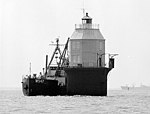Gibson Island (Maryland)
Gated communities in MarylandLandforms of Anne Arundel County, MarylandMaryland islands of the Chesapeake BayUnincorporated communities in Anne Arundel County, MarylandUnincorporated communities in Maryland

Gibson Island is an island and unincorporated community on the western shore of the Chesapeake Bay. It is part of Anne Arundel County, Maryland, United States and is the eastern terminus of Maryland Route 177. It is connected by a causeway to Pasadena, Maryland. The two locations do not share a ZIP code.
Excerpt from the Wikipedia article Gibson Island (Maryland) (License: CC BY-SA 3.0, Authors, Images).Gibson Island (Maryland)
Ayrlie Water Road,
Geographical coordinates (GPS) Address Nearby Places Show on map
Geographical coordinates (GPS)
| Latitude | Longitude |
|---|---|
| N 39.074166666667 ° | E -76.423888888889 ° |
Address
Ayrlie Water Road 617
21056
Maryland, United States
Open on Google Maps






